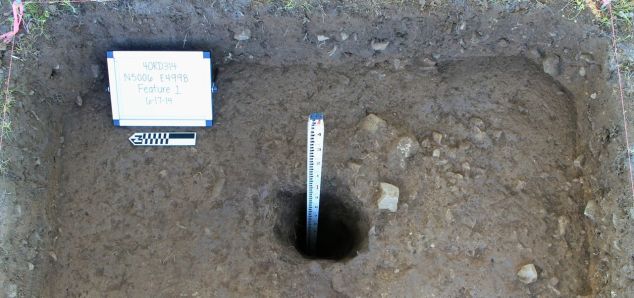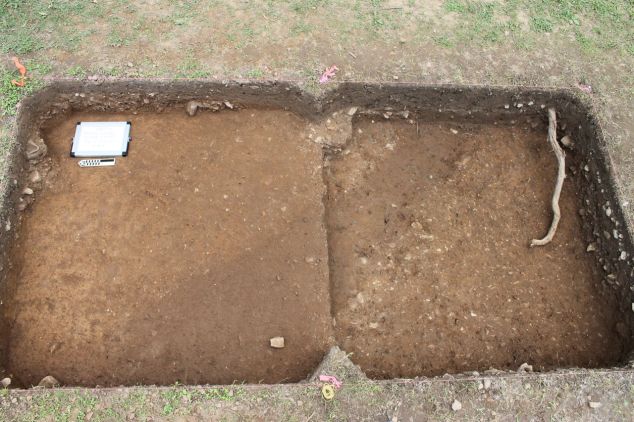— post by Dr. Peres
I know the blog has been quiet the past few days and for that I apologize. We have finished Week 6 and are now into the home stretch! Our days on site are less about the physical nature of our work (though it is still not for the out-of-shape) and more about the intellectual side of archaeology. One of the aims of archaeological excavations is to uncover physical evidence of humans whereabouts and activities in a given area. Of course artifacts (any object made, modified, or used by humans) can tell us some of this, but what really interests archaeologists are the features (evidence of human activity that cannot be removed, such as a post hole or hearth). The remote sensing work that was completed at the site is the basis for our excavation strategy. We are targeting several areas of intense anomalies.
Week 6 was about identifying features in the floors of our excavation units as soon as possible (which is one of the reasons archaeologists dig in small controlled increments), then open up more units as necessary to expose the entire surface of any given feature. This has resulted in a total of 19 excavation units open: 16 of these are 2 meter x 2 meter squares and the remaining 3 are 1 meter x 2 meter rectangles. We have exposed a total of 8 features, most of which are large and occupy more than one excavation unit. Here is a quick summary of what we know about Features 1-5 this far.
Feature 1: a posthole — not modern, maybe historic, likely older than that. This feature was first thought to be a natural tree feature, as the top outline was circular, but without distinct edges. In actuality it was the very top of the post hole, something we rarely, if ever, see in Southeastern Archaeology as most features have had the top 20-30 centimeters plowed off. Lucky for us, our site has never seen a mechanical plow. In fact, according to Susan’s research, Magnolia Valley has almost exclusively been in horse pasture. I know I have never worked on a site in the Southeastern US that did not have a deep and oftentimes destructive-to-the-site plowzone.
This feature was excavated to a depth of over 1 meter.
Feature 2: the historic two-track horse and wagon/buggy/carriage road. (Pictures to follow another day.)
Feature 3: a possible earth oven.
Feature 4: very large feature located to the north of Feature 3. We have opened seven 2 m x 2m and one 1 m x 2 m units to expose this feature in its entirety. We will work on documenting and excavating this during our final week on-site. We anticipate their being additional features within this one large one.
Feature 5: a long, mostly linear, slightly curving trench-like feature. We have it exposed in three 2 m x 2 m units. What is exposed is being excavated.
Features 6-8 are still in need of further defining before we can discuss them in any depth.
Also this week we saw a number of visitors to the site. We had a local school group of students, parents, and several teachers come and learn about archaeology with some hands-on activities. A number of MTSU faculty and alumni stopped in (and brought popsicles!) to check out our work. We love sharing what we are learning with our friends, colleagues, and anyone that is interested.
Stay tuned as we work to finish up an exciting field season at Magnolia Valley!


